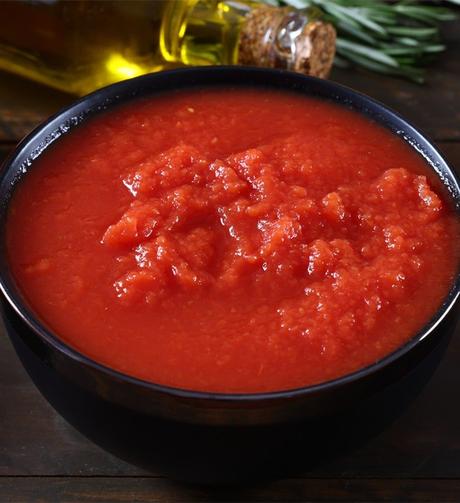
Tomato puree is a thick liquid prepared by pureeing lightly cooked tomatoes. It has a deep tangy taste that adds a delicious burst of flavor to diverse dishes including tomato-based sauces, dips, salsas, and curries. It is easily available in most grocery stores and commonly used in a wide range of cuisines.
Running out of this staple can put your dinner plans in a bind. Fortunately, you can use any of these 7 tomato puree substitutes - they'll help you achieve a similar flavor, texture, and consistency and make your dishes taste equally delicious!
1. Tomato Paste
Tomato paste is essentially made by cooking down tomatoes to form a thick paste. It has a concentrated, deep, sweet, and meaty flavor that can add a lot of taste, texture, and body to several dishes from salsa and dips to stews to casseroles. It is also easily available in grocery stores.
Because of its easy accessibility and similarities in flavor and texture to tomato puree, tomato paste is an excellent substitute for the original ingredient. However, as tomato paste tends to be more concentrated than tomato puree, you'll need to dilute it with water to mimic the texture and thickness of canned puree. Once diluted, you can use it in your recipes as-is without any flavoring agents.
1 cup tomato puree = 1/3 cup tomato paste + 2/3 cup water.
2. Tomato Sauce
Depending on the ingredients used, tomato sauce offers a wide range of flavors from sweet and acidic to umami. It has a less developed flavor than tomato puree but will work well in a range of recipes.
Remember, tomato puree is unseasoned while tomato is often seasoned and spiced with vinegar and herbs. So, make sure you reduce the amount of spices and flavoring agents in the recipe when using it as a substitute. It also has a thinner texture that can change the consistency of the recipe, so you might want to thicken it in a saucepan to compensate for its consistency.
1 cup tomato puree = 1 cup tomato sauce.
3. Marinara Sauce or Pizza Sauce
Typically used as a dipping sauce or on pizza, both marinara and pizza sauces have a fresh tomato flavor and a velvety texture. They are often flavored with other ingredients like garlic and herbs and add a spectacular flavor to recipes.
But, as these sauces can bring an Italian flavor to your recipes, we recommend using them exclusively in dishes that require a similar flavor to shine such as meatball subs, eggplants, pasta, and dips. Or, you can alter the amount and number of condiments and spices in your recipes when substituting for tomato puree to ensure it doesn't overpower your dish.
1 cup tomato puree = 1 cup marinara/pizza sauce.
4. Fresh Tomatoes
Tomato puree is made from ripe tomatoes. So, if you run out of canned tomato puree but have a batch of ripe tomatoes at hand, consider making your own tomato puree. We recommend using roma tomatoes for the best results, but if you don't have any, use any tomatoes you have available to make this fresh, succulent pantry staple.
To turn your fresh tomatoes into tomato puree, simply boil and simmer chopped tomatoes for 10-15 minutes, or until they break down. Allow the tomatoes to cool before removing the seeds and peels using a food mill or sieve. Blend the puree until smooth, then use it in dishes as you would tomato puree!
1 cup tomato puree = 4 cups of fresh tomato sauce.
5. Canned Tomatoes
Canned tomatoes are tomatoes (usually peeled) that have been sealed in a can after being processed using heat. They have a strong flavor profile that works well in sauces, stews, and other dishes. Since canned tomatoes are also widely available in stores, it is one of the most practical substitutes when you're out of the original ingredient.
Because canned tomatoes are a chunkier form of tomato puree, you'll need to combine them with the leftover liquid and blend until you get the desired consistency. You also won't need to add any flavoring agents as tomato puree is unseasoned.
1 cup tomato puree = 1 cup canned tomatoes.
Use canned tomatoes as the last resort as you will need to use the full contents of the can within 5-7 days (with refrigeration) or it will go bad.
6. Ketchup
A popular condiment in many houses, ketchup is made with tomatoes and a host of other ingredients such as vinegar, sugar, salt and seasonings, water, and more. It has a sweet and tangy flavor that is commonly paired with fried and greasy hot foods. Ketchup is also used in various dressings and sauces as the base ingredient.
When substituting tomato puree for ketchup, bear in mind that tomato puree is unseasoned, but ketchup has a range of spices and flavors. So, you may need to reduce the number of flavorings in your recipes to reach the desired results. Because of its strong flavor, ketchup should only be used in dishes where a little amount of puree is required.
1 cup tomato puree = 1 cup ketchup.
7. Pumpkin or Squash Puree
Pureed pumpkin or squash both belong to the same gourd family and have a strong herbaceous flavor. They are preserved in a can in the same way as tomato puree. Although pumpkin and squash puree both have a thicker consistency like tomato paste, they can be used as a stand-in for tomato puree in a pinch.
When substituting squash or pumpkin puree for tomato puree, keep in mind that gourds do not have much juice. So, their purees are significantly drier than tomato puree. You can remedy that by adding some oil or water to the mix. In terms of flavor, both pumpkin/squash and tomato puree have subtle flavors that are enhanced by other spices and flavorings, so the difference will be minimal.
1 cup tomato puree = 1/2 cup pumpkin or squash puree.
